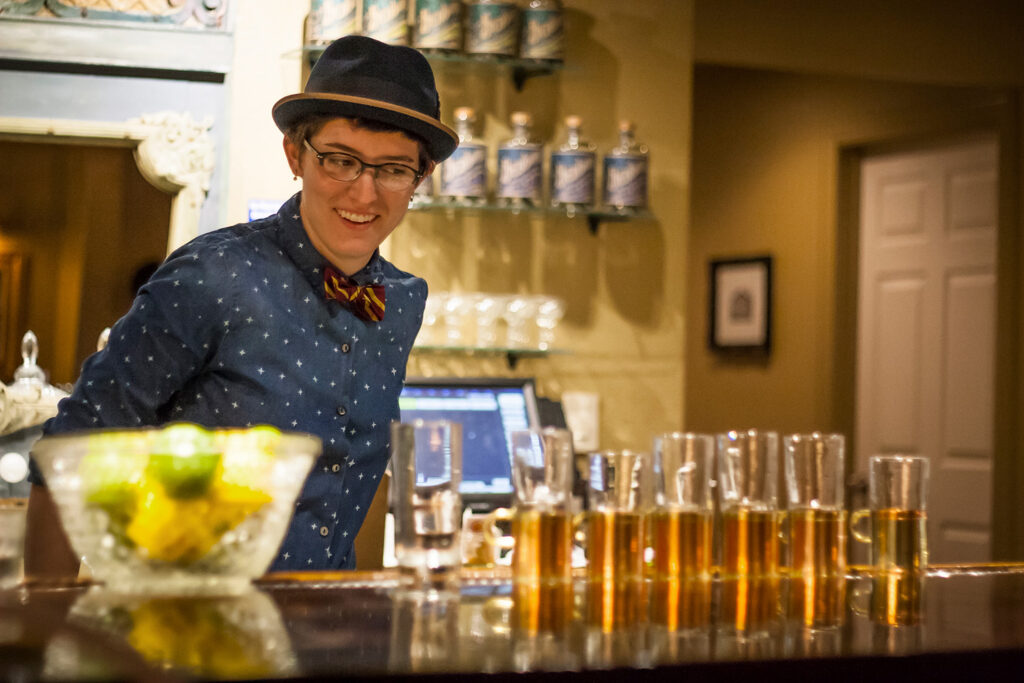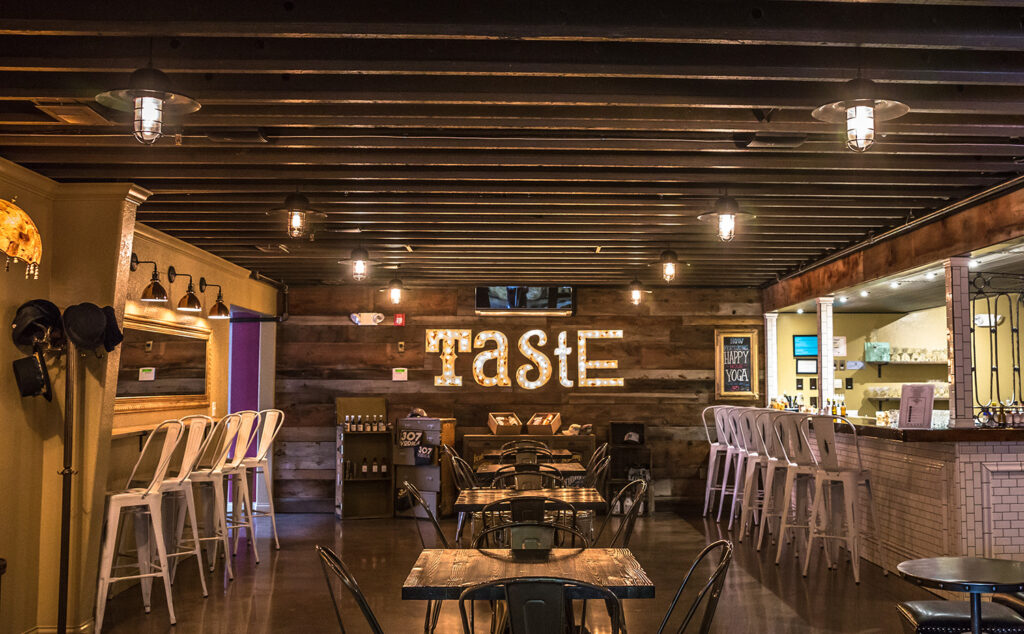
Opening a tasting room was a key component of the business plan long before Backwards Distilling Co. started producing spirits. Six years after co-founding the distillery in Mills, Wyoming, with her brother and parents, Amber Pollock continues to see the benefits of that plan.
“Most consumers don’t know what to do with straight spirits—it’s not a finished product for [them] where it is a finished product for a distiller,” says Pollock, who manages the Backwards tasting room in Casper and serves on the American Craft Spirits Association’s Board of Directors. “There’s a number of steps they have to take after that purchase to create something that they’re going to sit down and enjoy … Using your tasting room platform as a way to drive cocktail culture and drive consumers’ interest in cocktails is something that all distilleries should be focusing on.”
For many distilleries, operating a tasting room not only helps drive interest in cocktails but it can also boost sales while increasing brand awareness and a better understanding of distilled spirits. Whether you are planning to open a distillery, are running an established distillery without a tasting room, or are looking to evolve your tasting experience, the following tips should prove helpful in creating a welcoming, educational space for your customers.

Be adaptable and know your customers.
When Cardinal Spirits in Bloomington, Indiana, first opened its tasting room, the distillery partnered with food trucks with mixed results. “Food trucks are great except they have wheels and sometimes those wheels would take them away from our parking lot,” says co-founder Jeff Wuslich. “We didn’t have food when we needed to have food or maybe the food service experience wasn’t as ideal as we would have wanted it and the customers saw us as one and the same.”
After listening to consumer feedback, Cardinal Spirits decided to add a kitchen. Today, Wuslich says the tasting room represents about one-third of the distillery’s revenue.
“I think one of the fun things for us is figuring out what a distillery’s kitchen looks like,” says Wuslich. “In America we know what a brewpub looks like … but what does a distillery look like? Is it a little more elevated? What pairs well with cocktails? A core tenet of what Cardinal is trying to do is get more people to enjoy spirits in a fun way, so we couldn’t go too high class. We wanted to have an approachable menu like we have for our cocktails but still more refined than just bar food.”
Invest in people.
Turnover rates are high in the service industry, and while there may not be a surefire way to avoid this challenge altogether, Wuslich offers one piece of advice to lessen stress on distillers.
“Overpay for management, because if you don’t have a lot of restaurant experience, it’s not something that you necessarily want to own,” says Wuslich. “If you want to be working your still all the time, then you want somebody managing your tasting room and your bar and your kitchen so that you don’t have to worry about it.”
A 2013 state law paved the way for distilleries to operate tasting rooms in Indiana, and it wasn’t long after that Cardinal gravitated to making cocktails. Hiring creative bartenders led to an unexpected twist for the distillery.
“Originally we thought we would be trying really interesting and different things in the production area and letting the bartenders try it out for us,” says Wuslich. “I think it works in the opposite way where sometimes bartenders are saying, ‘Oh man, you know what we really need is something like this,’ and then we in the back make something interesting that they would enjoy.”
One example is Cardinal’s Tiki Rum, a light rum with a fruity profile that was crafted for the distillery’s Tiki Tuesday cocktail nights. “We had rum on the agenda to make, but it definitely got accelerated because we had some bartenders that really loved tiki drinks,” says Wuslich.
Be hospitable.
For distilleries located in or near urban areas, Arthur Hartunian of Napa Valley Distillery in Napa, California, recommends avoiding reservation policies. Although Napa Valley’s website says reservations are required, Hartunian says most visitors to the distillery’s grand tasting salon never visit the site, and instead learn about the distillery via Yelp or from walking by the front door.

“We recommend reservations but we never turn anyone away if they walk in unannounced on a day that we’re closed,” says Hartunian. “If someone has made an effort to come here, we’re going to do our best to give them some sort of experience. The distillery is our home [and] if someone knocks on our door and wants to visit, the last thing you want to do is turn them away because they’re going to remember that. They’re going to forget your brand.”
Visitors to Napa Valley Distillery will soon have the option of tasting the distillery’s straight spirits at its tasting salon and/or having a cocktail and food at The Hollywood Room, which Hartunian says will provide “a little nibble of Hollywood” meets Miami Beach. “It’s a small room so we’re going to be really creative with the colors and textures,” he continues. “It’s going to be mid-century Hollywood—the glamor era of Hollywood.”
Carefully develop a creative but approachable cocktail menu.
At Backwards Distilling’s new tasting room in Casper (prior to May, the company operated a tasting room at its distillery in nearby Mills), a circus esthetic is king, with spirits like Ringleader Vodka and Strong Man Gin playing starring roles in cocktails. Pollock creates a new menu for each season with roughly two dozen cocktails offered. One of her strongest pieces of advice for running a tasting room is to make sure that the cocktail menu isn’t an afterthought. She recommends taking “extra time to make sure that every cocktail is really good and if that’s the first cocktail somebody has tried, will they order more cocktails after that? Or are we going to scare them away and they’ll go back to their comfort zone which is beer or whatever they were drinking?”
Understanding that all of her customers may not be cocktail savvy, Pollock aims to use plain English on the menu, which starts with approachable options like the Big Top—made with vodka, grapefruit juice, lime juice, tarragon syrup and bitters—and gets progressively more adventurous. “We don’t try to make it sound fancy,” says Pollock. “If you go to a place and can’t read any of the ingredients or don’t know what they are when you’re reading the menu, you’re going to be scared away. You’re not going to take that risk even if it had been something you really liked.”

When a consumer is on the fence about ordering an old favorite versus making the leap to a more adventurous cocktail—such as a recent winter offering that promised “a savory take on butternut squash featuring a rich, brown butter washed vodka”—Pollock provides a safe landing. “I always tell them, ‘This is a very low risk situation. If you don’t like this I’ll make the one you had last time or make you something else,’” Pollock says. “It’s definitely about the bigger picture. If you have to eat a little bit of cost on that wasted cocktail, it’s pretty negligible in the end compared to the value of getting somebody excited about drinking cocktails over all.”
Use fresh ingredients.
Pollock is also passionate about preparing cocktails with fresh-squeezed juices. Rather than buying bottled juice, she believes that distilleries have a responsibility to set a high bar for cocktails by using fresh citrus.
“I think committing to that should be baseline for everybody that’s trying to promote and get consumers excited about tasting cocktails,” says Pollock. “You can do that without adding a whole lot of cost and a whole lot of time. That sets a good example that this is the standard for a cocktail.”
Create eye-catching drinks.
Finally, it doesn’t hurt to dress up the drinks.
Pollock carefully considers the appearance of her cocktails, including glassware and garnishes. The more photogenic the drink, the more likely customers will be to take a photo of it and share it on social media. “Every drink has its own personality and own theme,” says Pollock. “That encourages people to take more pictures than if six Collins glasses come to the table.”
And the appearance of some drinks may inspire consumers to try something they wouldn’t normally order. A recent example at Backwards is Augmented Aquarium, a blue-tinted gin and tonic. “People see it and they want it,” says Pollock “With drinks like that you can get people excited about being in your place and that makes it [unique]. Do something that plays into whatever personality you’re trying to evoke.”

